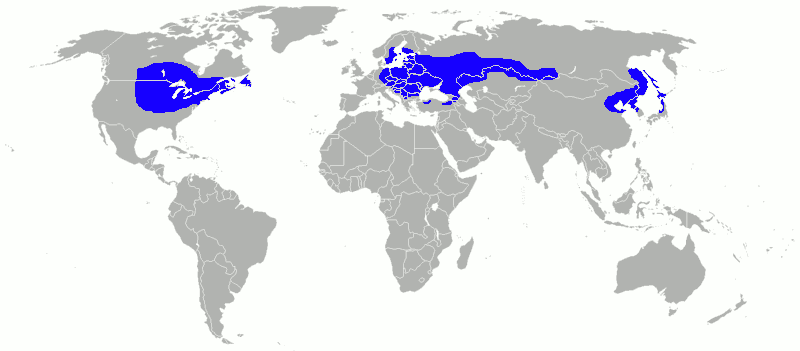One of the things that I find interesting about gardening is something that many gardeners probably don't think very much about - where the plants in the garden originally came from. Most garden plants, whether flowers, herbs, or vegetables, have been selectively bred to some degree to produce larger flowers or leaves or roots, but most of them still have a lot in common with their wild ancestors. So, in a sense, even an average suburban garden is a sort of herbarium or botanical garden with specimens that originate in various parts of the world. Here are just a few samples from my particular garden:
 Dicentra eximia
Dicentra eximia -
Wild bleeding heart; native to
eastern United States, mainly Appalachian mountains
 Syringa vulgaris
Syringa vulgaris -
Common lilac; native to the
Balkan peninsula of southeastern Europe

 Podophyllum peltatum
Podophyllum peltatum -
Mayapple; native to
eastern United States
 Cercis canadensis
Cercis canadensis -
Eastern redbud; native to
eastern United States (but not Canada, in spite of the name)
 Centaurea cyanus
Centaurea cyanus -
Cornflower or
Bachelor's button; native to
most parts of Europe
 Rosa carolina
Rosa carolina -
Pasture rose or
Carolina rose; native
to eastern United States and southeastern Canada
 Rudbeckia hirta
Rudbeckia hirta -
Black-eyed susan; native to
central and eastern United States and Canada
 Athyrium niponicum
Athyrium niponicum -
Japanese painted fern; native to
Japan (duh!), northern China, Korea, Taiwan
 Leucanthemum x superbum - Shasta daisy
Leucanthemum x superbum - Shasta daisy; hybrid of two species
native to Europe -- with
Apis mellifera -
Honey bee; native to parts of Asia,
Africa, and Europe
 Dicentra spectabilis
Dicentra spectabilis -
Bleeding heart or
Lyre-flower; native to
southeastern Siberia, northern China, Korea, and Japan

 Rhododendron maximum - Great rhododendron
Rhododendron maximum - Great rhododendron; native to
eastern United States and southeastern Canada
You may notice that all of these plants are natives of either eastern North America, Europe, or the northern China-Korea-Japan area. This isn't an accident - the northeastern part of the United States has a type of climate sometimes known as
humid continental. There are three large areas of land on earth that have this climate:

Image from
here on Wikipedia - see
this article.
The native ranges of most of the common (and quite a few of the less common) garden plants that grow in the northeastern United States fall mostly within one of these three zones.
 Cercis canadensis - Eastern redbud; native to
Cercis canadensis - Eastern redbud; native to Rosa carolina - Pasture rose or Carolina rose; native
Rosa carolina - Pasture rose or Carolina rose; native Leucanthemum x superbum - Shasta daisy; hybrid of two species
Leucanthemum x superbum - Shasta daisy; hybrid of two species Dicentra spectabilis - Bleeding heart or Lyre-flower; native to
Dicentra spectabilis - Bleeding heart or Lyre-flower; native to









No comments:
Post a Comment